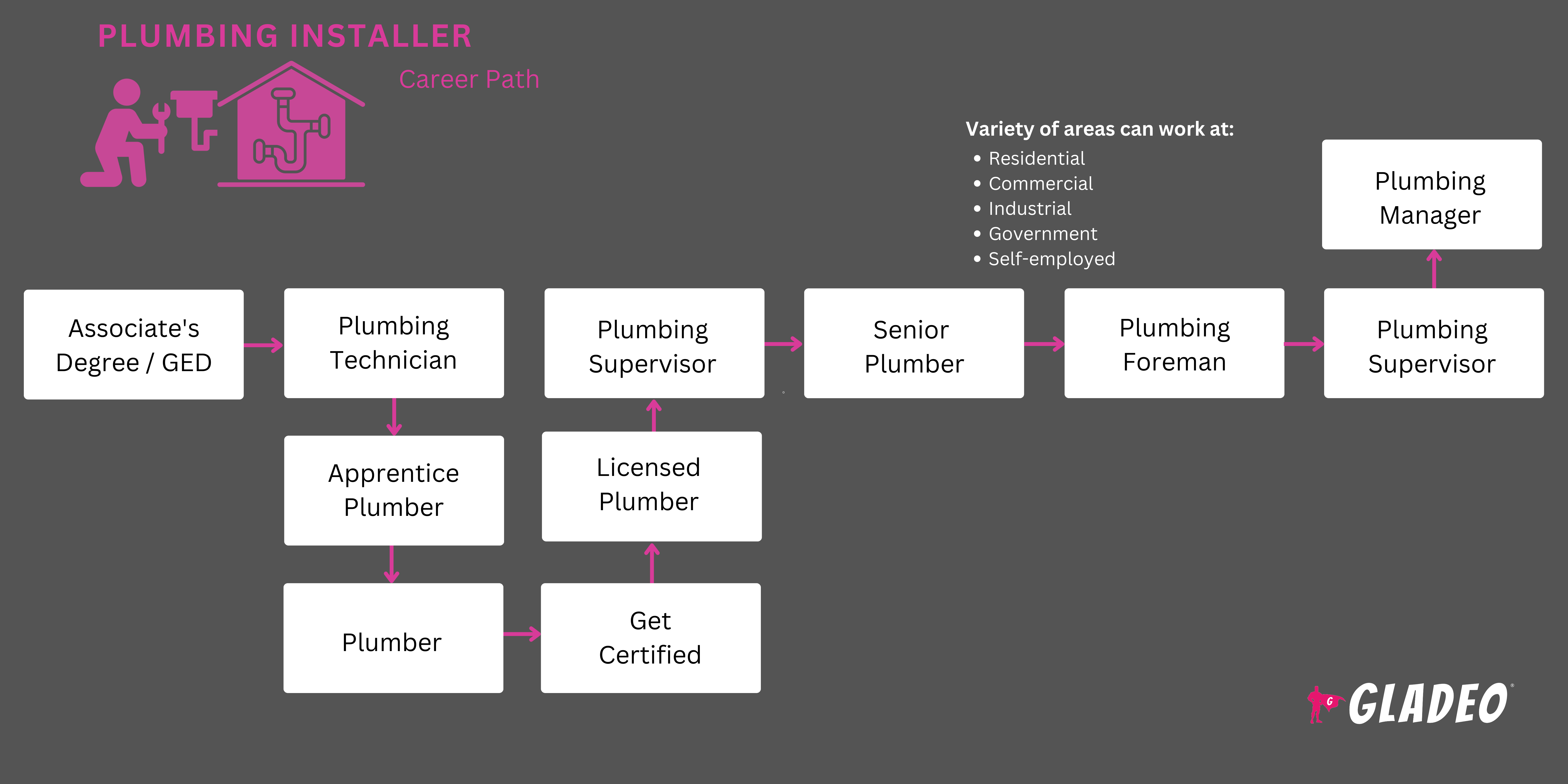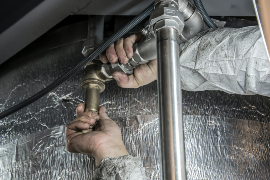Focos de atención
Plumber, Plumbing Technician, Plumbing Contractor, Plumbing Supervisor, Pipefitter, Drainage Engineer, Plumbing Inspector, Plumbing Estimator, Gas Fitter
Most of us take indoor plumbing for granted because we grew up with it. But many of us still have relatives who were alive when such conveniences were far from common. Indoor plumbing didn’t start to become accessible until the 1930s. Even by 1940, “nearly half of the houses lacked hot piped water, a bathtub or shower, or a flush toilet” in America!
Fast forward to today and we couldn’t imagine life without running water in our homes, schools, and offices. And it’s all thanks to the hard work of Plumbing Installers—skilled tradespeople who specialize in installing and maintaining the pipes, fixtures, and equipment used for water distribution and disposal. They also install and repair heating, ventilation, and air conditioning (HVAC) units and water heaters.
Their role requires knowledge of complex plumbing systems, the ability to read and interpret blueprints, and a commitment to safety and building code adherence. But their job titles may vary, with some employers using terms like service plumber, commercial plumber, or pipefitter. Whatever term we call them, they work in an indispensable trade that modern society can’t live without.
- Job satisfaction from solving problems and ensuring safe, functional water systems
- Opportunities for independent work and entrepreneurship
- High demand leading to job security
- Potential for advancement and specialization
Horario de trabajo
- Plumbing Installers typically work full-time, with overtime often required to address emergencies or meet deadlines. Work schedules may include evenings and weekends, especially for those who are self-employed or on call. Frequent travel is needed to reach job sites.
Tareas típicas
- Meet with customers, contractors, construction workers, and electricians to go over projects, timeframes, and budgets
- Inspect structures to assess material or equipment needs, establish a sequence of pipe installations, or plan around obstructions
- Review blueprints to determine the layout of systems and materials
- Estimate time, material, or labor costs. Prepare cost estimates or bids
- Inspect work sites for obstructions or holes that could cause structural weakness
- Locate positions for installations, connections, holes, or fixtures
- Lay out drawings of pipe systems, supports, or related equipment, per blueprints
- Plan pipe system layout, installation, or repair
- Select pipe sizes, types, and materials such as supports or hydraulic cylinders
- Install plumbing systems (pipes, fixtures, sinks, toilets, and water heaters)
- Inspect existing systems and components. Replace worn parts, as needed
- Shut off gasses or liquids from pipe sections using valve keys or wrenches
- Install underground storm, sanitary, or water piping systems
- Measure, cut, thread, and bend pipe using hand and power tools or machines
- Attach pipes to walls, structures, or fixtures using brackets, clamps, or welding
- Anchor steel supports from ceiling joists to hold pipes in place
- Replace defective washers and open clogged drains
- Cut openings accommodate pipes or pipe fittings
- Install fixtures, appliances, or equipment designed to reduce water or energy consumption
Responsabilidades adicionales
- Fill pipes or fixtures with water or air. Observe pressure gauges to detect leaks
- Troubleshoot and fix installation issues to ensure systems function correctly
- Train and mentor junior installers. Direct helpers engaged in pipe cutting, preassembly, or installation of components
- Adhere to codes and safety standards. Ensure work meets legal requirements
- Stay up-to-date with technologies and materials to improve efficiency and quality
- Maintain an accurate inventory of supplies and tools. Order new stock as required
- Document installation processes. Keep records of materials used for each project
Habilidades blandas
- Capacidad para trabajar de forma independiente
- Atención al detalle
- Pensamiento crítico
- Destreza
- Dominio del inglés
- Flexibilidad
- Organización
- Persistencia
- Resolución de problemas
- Ingenio
- Conciencia de seguridad
- Buen juicio y toma de decisiones
- Fuerza y resistencia
- Gran capacidad de comunicación
- Gestión del tiempo
- Visualización
Habilidades técnicas
- Ability to read blueprints/technical diagrams with layout visualization software
- Proficiency with plumbing tools and equipment (wrenches, pipe cutters, threading machines, and soldering irons)
- Installing smart plumbing devices (touchless faucets, smart water heaters, etc.)
- Experience with green plumbing practices and products
- Expertise in welding and soldering techniques
- Plumbing inspection technologies for diagnosing hidden pipe issues
- In-depth knowledge of building codes and regulations
- Emergency and safety equipment (backflow preventers, gas leak detectors, etc.)
- HVAC systems and tools
- Hydraulic calculations to determine water supply needs and pipe and fixture sizing
- Understanding of water supply and waste management systems (principles of water pressure, venting, and septic system operations)
- Gobierno
- Construcción pesada y de ingeniería civil
- Fabricación
- Plumbing, heating, and air-conditioning contractors
- Trabajadores autónomos
The job of a Plumbing Installer can be physically demanding at times, working in tight spaces, lifting heavy objects, and being exposed to various environmental conditions. There’s also the ongoing risk of personal injuries from tools, materials, and work environments. Sometimes, installers may have to be “on call” in the event of an emergency, which can lead to long work hours.
In addition to being masters of their trade, Plumbing Installers must be devoted to continuous learning to keep up with new technologies such as the Internet of Things (IoT), updated building codes, as well as trends such as green plumbing practices. Any serious flaws in their work can lead to potentially hazardous and expensive leaks.
There’s a high demand for the services of Plumbing Installers in areas experiencing rapid construction growth and where buildings are being retrofitted with modern, efficient systems.
Added to this trend is the growing emphasis on water conservation and sustainable plumbing solutions. Part of these efforts is the increasing use of smart plumbing technology and automation. The integration of IoT in plumbing has revolutionized water systems monitoring and management, allowing for real-time tracking of usage and leak detection, as well as remote control of fixtures. This technology enhances efficiency and convenience while it contributes to reducing unnecessary waste!
Plumbing Installers are often very analytical and hands-on. They may have enjoyed assembling things in their youth, such as sophisticated LEGO sets or other projects, or they could’ve loved building things in shop class with tools. In addition, they might have had a knack for math.
Educación
- Plumber Installers need at least a high school diploma or GED but don’t need a college degree. They learn their trade via sponsored apprenticeships which can last 4 or 5 years
- El aprendizaje incluye unas 2.000 horas de formación práctica y técnica, como códigos de fontanería, uso adecuado de herramientas y equipos, seguridad y matemáticas y física aplicables.
- Algunos trabajadores participan en programas de preaprendizaje de organizaciones como:
- Instituto de Constructores de Viviendas
- Asociación de Contratistas de Fontanería, Calefacción y Refrigeración
- Sindicato Norteamericano de la Construcción
- In some cases, Plumbing Installers work their way into apprenticeship programs from other entry-level positions
- Muchas escuelas universitarias y de formación profesional ofrecen cursos de fontanería breves y asequibles.
- Plumbers must pass a state-specific journeyman plumbing test to get licensed. Those who work on gas piping need an additional license
- Hay docenas de programas de certificación opcionales, entre ellos:
- American Society of Plumbing Engineers - Certified in Plumbing Design; Certified Plumbing Design Technician
- Association for Materials Protection and Performance - Internal Corrosion Technologist
- International Association of Plumbing and Mechanical Officials - Backflow Prevention Assembly Tester Certification; Service Plumbing Certification; UPC Residential; Commercial Plumbing Inspector; Plumbing Plans Examiner
- International Code Council - Plumbing Plans Examiner; Commercial Plumbing Inspector
- National Inspection, Testing and Certification Corporation - IAPMO Plumbing Inspector; Journey Level Pipefitter-Steamfitter; STAR Fire SprinklerFitter Mastery
- A college degree isn’t required for this field. Students who do take college courses should ensure programs have a good reputation. Review their Better Business Bureau profile and Google Business feedback
- Considere el coste de la matrícula, los descuentos y las oportunidades de becas locales (además de la ayuda federal)
- Busca cursos que te ayuden a desarrollar habilidades prácticas
- Piensa en tu horario y en tu flexibilidad a la hora de decidir si te inscribes en un programa presencial, online o híbrido
- Tenga en cuenta que algunos programas de formación pueden tener contactos con empresas locales.
- Asistir a clases de taller en el instituto para adquirir experiencia práctica con las herramientas más comunes.
- Lleva un registro de las herramientas y equipos que aprendes a utilizar
- Study math topics including basic arithmetic, measurements, geometry, algebra, trigonometry, fractions, proportions and ratios, and percentages
- Sign up for community college or vocational training classes to learn about plumbing and HVAC equipment installation, maintenance, and repair, plus metalwork, blueprint reading, welding, safety, and CPR/first aid
- Safety is a critical topic to study because plumbing work entails hazards such as hot pipes, risk of falling when working from heights, cuts, exposure to chemicals, waste, mold, and other dangers
- Haz voluntariado o trabaja a tiempo parcial para acumular experiencia laboral práctica; quedará bien en el currículum o en la solicitud de empleo.
- Consider offering a helping hand at a local Habitat for Humanity
- Apply to local pre-apprenticeships or apprenticeship programs when you are ready
- Learn more about plumbing by studying books, articles, and video tutorials
- Ver vídeos en YouTube o programas que muestren cómo es el día a día en esta carrera.
- Comenzar una rutina de ejercicios para aumentar la fuerza, la resistencia y la flexibilidad.
- Obtenga su licencia de conducir para poder llegar a los sitios de trabajo
- Ask a Plumbing Installer if you can shadow them to learn about day-to-day activities and tools used

- La mejor manera de conseguir cualquier trabajo es estar cualificado o ser formable. Si no tienes las credenciales académicas o la experiencia laboral necesarias, demuestra en una solicitud de aprendizaje que merece la pena invertir en ti.
- Work with your school’s program or career center to locate and apply for jobs or apprenticeships
- Check out sites like Apprenticeship.gov, CareerOneStop, Department of Labor Employment and Training Administration, and Helmets to Hardhats for info on opportunities
- Sign up for alerts on job portals such as Indeed, Simply Hired, Glassdoor, and Zippia, as well as Craigslist for smaller, local opportunities
- If you can work part-time in a related field to learn the ropes beforehand, do so! Shadow your mentor or boss, ask questions, and gain skills
- Call local companies who hire Plumbing Installers or visit their websites for job postings
- Check out examples of Plumbing Installer resumes, if needed. Include applicable keywords in your resume, such as:
- Brazing
- Códigos de edificación
- Caulking
- Copper Pipe
- Dishwashers
- Garbage Disposals
- Hand Tools
- HVAC
- Pipe Installations
- Pipe Systems
- Plumbing
- Potable Water
- PVC
- Torches
- Water Heaters
- Review Plumber interview questions to prepare for interviews
- Tell everyone in your network you’re looking for work!
- Know and comply with safety standards and always wear your protective gear. Nothing angers an employer more than a preventable workplace mishap
- Be on time for work and prepared for the day’s tasks
- Master every skill and perform the highest quality of work possible for your customers
- Take excellent care of your tools and inventory and don’t lose track of items
- Knock out additional courses, volunteer to attend training, and get certified in advanced or specialized duties
- Hable con su jefe Lo más probable es que tenga muchos conocimientos, pero a veces no ofrece información a menos que se le pregunte directamente.
- Take the initiative to study technical manuals and learn directly from manufacturers’ representatives when you interact with them
- Infórmese sobre tendencias y novedades
- Train new workers once you’re qualified. Set the bar high for them and lead by example
Páginas web
- Instituto de Aire Acondicionado, Calefacción y Refrigeración
- Contratistas de Aire Acondicionado de América
- Asociación Americana de Rociadores contra Incendios
- Sociedad Americana de Ingenieros de Calefacción, Refrigeración y Aire Acondicionado (ASHRAE)
- Sociedad Americana de Ingenieros de Fontanería
- Sociedad Americana de Soldadura
- Aprendizaje.gov
- Constructores y Contratistas Asociados
- Contratistas Generales Asociados de América
- Departamento de Trabajo Administración de Empleo y Formación
- De los cascos a los cascos protectores
- Instituto de Constructores de Viviendas
- Excelencia HVAC
- Asociación Internacional de Maquinistas y Trabajadores Aeroespaciales
- Asociación Internacional de Oficiales de Fontanería y Mecánica
- Hermandad Internacional de Trabajadores de la Electricidad
- Asociación de Contratistas Mecánicos de América
- Asociación Nacional de Constructores de Viviendas
- Sindicato Nacional de la Construcción
- Centro Nacional de Educación e Investigación de la Construcción
- Asociación Nacional de Protección contra Incendios
- Asociación Nacional de Rociadores contra Incendios
- NCCER
- North America’s Building Trades Unions
- Excelencia técnica norteamericana
- Ayudante de fontanería en línea
- Plgb
- Asociación de Contratistas de Fontanería, Calefacción y Refrigeración
- PlumbingNet
- FontaneríaWeb
- Asociación de Ingenieros y Técnicos del Frío
- Sociedad de Ingenieros de Servicios de Refrigeración (RSES)
- thePlumber.com
- United Association of Journeymen and Apprentices of the Plumbing and Pipe Fitting Industry
- Trabajadores Siderúrgicos Unidos
Libros
- Plumbing 101, by PHCC Educational Foundation
- Plumbing Complete: Expert Advice from Start to Finish, by Rex Cauldwell
- Plumbing Design and Installation, by L. V. Ripka
- PEX Pipe Plumbing Techniques: A Comprehensive Guide For Reliable And Efficient Installations, by Cairo Richmond
Plumbing Installers have good career prospects, but the job can be very demanding at times. If you’re curious about some alternative career paths, check out the below-related options!
- Calderero
- Brazer
- Inspector de construcción y edificación
- Obrero de la construcción
- Director de la construcción
- Electricista
- Obrero de mantenimiento general y reparaciones
- Mecánico de calefacción, aire acondicionado y refrigeración
- Mecánico de maquinaria industrial
- Operario de mantenimiento de maquinaria
- Millwright
- Trabajador del transporte acuático
- Soldador
Newsfeed

Trabajos destacados

Cursos y herramientas en línea








